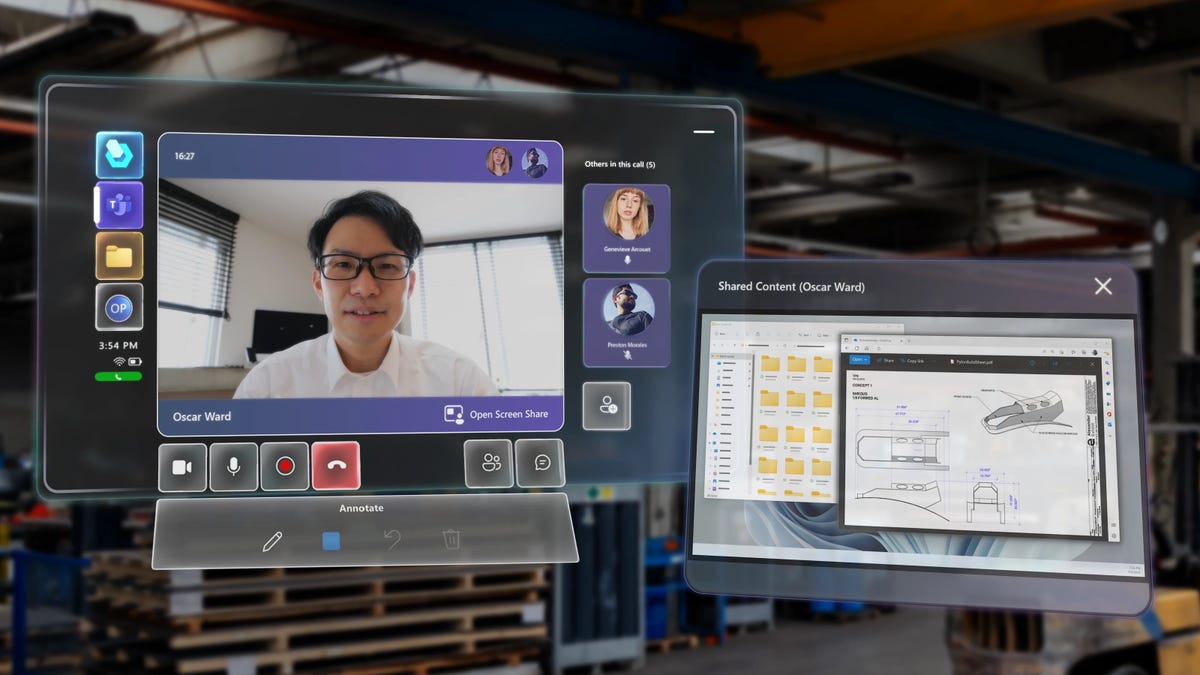HoloLens 2 users can call people directly, browse and add Microsoft Teams contacts to ongoing calls, or join a regular meeting just as they would do on any other device.
Few consumers have worn Microsoft’s HoloLens mixed reality headset, but engineers at enterprise customers like Toyota can now share Teams screens as holograms.
The new integration is part of Microsoft’s exploration of the industrial metaverse and lets HoloLens 2 users summon a range of holographic windows in a Teams call or chat. Users can also display a Pose BI dashboard, a Word document, a PDF, video, OneDrive folder, and calendar.
Also: Meetings in the metaverse: Our experience with HTC Vive Sync
The holographic windows can be opened, closed, resized and repositioned by the HoloLens 2 user. The two key updates for HoloLens 2 are Dynamics 365 Guides, which offers step-by-step holographic instructions, and Dynamics 365 Remote Assist, which lets others on a desktop or mobile see what the HoloLens wearer sees via a Teams call. The Teams desktop user can also annotate in a 3D space to assist the HoloLens user.
Microsoft is focused on engineers, support teams, and frontline workers who often don’t sit at a desk but need to participate in remote communications.
“Someone can grab a HoloLens, start a Guides session, and literally have a trainer in their head,” said Scott Evans, Microsoft’s vice president of mixed reality. “If they do need help, they can call an expert right from the app.”
Also: Metaverse and immersive experiences: How one company is getting started on the journey
There’s been uncertainty about Microsoft’s plans for HoloLens, but Microsoft does now suggest that there will be a HoloLens 3, with work underway on display, tracking, sensors, and battery life. HoloLens 2 was released in 2019, three years after the original HoloLens. Evans stressed that businesses, unlike consumers, don’t want new devices every two years.
“No one wants to be obsoleted for 10% better capabilities. They don’t need a successor yet, but they want to know it will be there at the right time,” he said.
“We’re just looking for the right design point to make it a meaningful update. They want a successor device that’s going to enable an even higher return on investment.”
Microsoft also showcased its ongoing work with the US Army on HoloLens. Microsoft landed a $22 billion HoloLens deal with the US Army in March 2021, but testing was delayed last October. Bloomberg reported this October that US soldiers testing the headset were experiencing headaches, eyestrain and nausea, according to a Pentagon report. The glow from the display was visible from hundreds of meters away, making it an unsafe tool in the battlefield, according to an account given to Business Insider.
Evans said the US Army is helping improve both software and hardware.
“The military program has its own set of requirements that are tuned to the needs of the soldier. So, it’s helping push the whole platform forward. It’s great to have early adopters that are driving requirements because you end up with this trickle-down effect,” he said.



